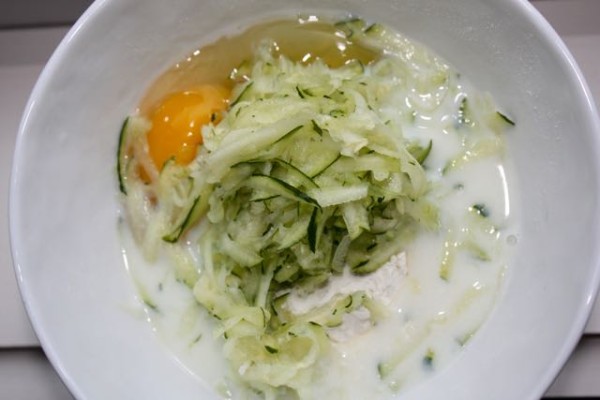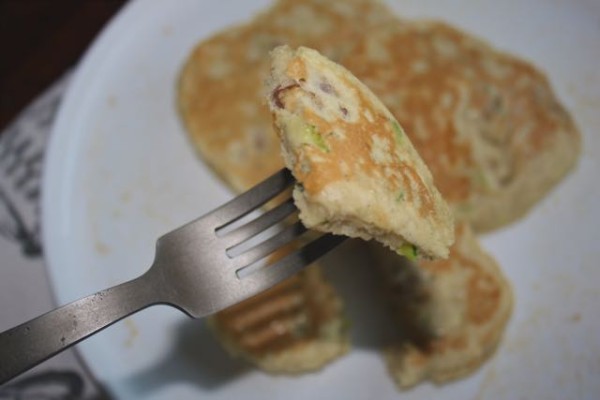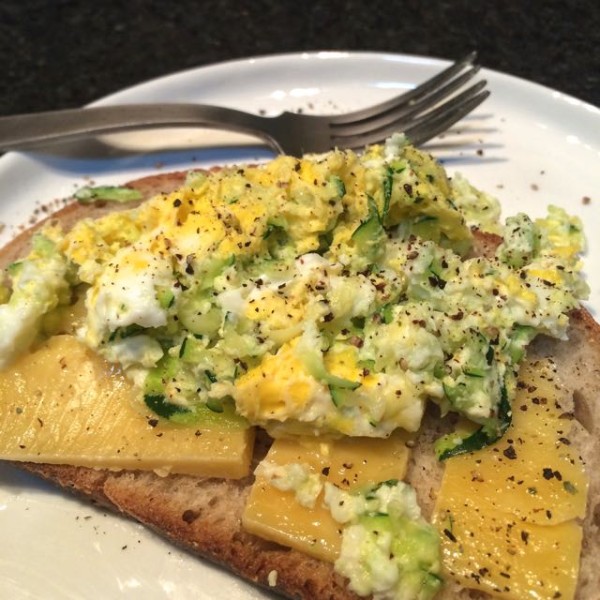It’s zucchini season. And I am good with that. Looking for zucchini recipe inspirations? Check out my layered zucchini stacks, zucchini breakfast cakes, zucchini pasta, and zucchini ribbons recipes. All suitable for the low FODMAP diet. Zucchini is a great source of potassium and Vitamin C. 1 cup of zucchini, sliced and cooked, has about 27 calories and 5 grams of carbs.
Today, I am sharing a recipe for zucchini walnut pancakes. These delicious pancakes can be eaten immediately or prepared in advance and frozen for later use. I actually like these slightly sweet veggie-infused pancakes for dessert!
I mixed up some gluten free pancake mix (feel free to make a suitable recipe from scratch), with some grated zucchini, vanilla extract, cinnamon and some chopped walnuts too. 
Adding grated zucchini to recipes is my latest little trick to boost my veggie intake.
In fact, this was my dinner last night: whipped up scrambled eggs with add grated zucchini. I microwaved one egg and 3/4 cup of grated zucchini (took 90 seconds)…how about that for fast food?
I tossed this yummy mixture on top of a slice of toasted sourdough bread topped with a few thin slices of sharp cheddar cheese. Adding active sourdough culture to wheat tends to lower the fructan (FODMAP) content, so you might work with your dietitian and try to incorporate some sourdough white bread into your low FODMAP diet, if desired, when you go through your re-introduction phase.
Still working out the blog updates…so bear with me while the blog is under construction!




Margaret VanDyke
Dear Kate, I’ve posted a plea a couple of times for a reply about taking a probiotic after being cleared of SIBO by rifaxim. I know you are very busy and do so much to help us but I am afraid to take them without your go ahead as it took a long time for me to fight off this SIBO. My doctor refused for a long time to give me the rifaxim. I have the VSL3 and some less potent probiotics and am just waiting to hear from you before risking it. Thank you so much if you can manage this.
katescarlata
Hi Margaret,
I can’t offer individual advice regarding your GI care–it would not be prudent without understanding your full medical history. I can tell you that I individualize probiotic needs post SIBO treatment based on residual symptoms. If the patient has underlying symptoms that were not resolved with the antibiotics, I might start a low dose probiotic. I am not in the ‘camp’ that more is better with probiotics. I like to start slowly and increase as needed. the gut environment is a very fragile ecosystem. Can you work with a dietitian to help guide your case?
Kate
Margaret VanDyke
Dear Kate, I am wondering if it’s a good idea to take a probiotic after being cleared of SIBO by rifaxim. I know you are very busy and do so much to help us but I am afraid to take them without your go ahead as it took a long time for me to fight off this SIBO. My doctor refused for a long time to give me the rifaxim. I have the VSL3 and some less potent probiotics and am just waiting to hear from you before risking it. Thank you so much if you can manage this.
Tara | Treble in the Kitchen
Amazing! Why have I never thought to add zucchini to pancake batter?!
katescarlata
So amazing, right, Tara!?! I am adding grated zucchini to my crustless quiche, scrambled eggs, savory gluten free biscuits…..so yummy!
Adina
Hi Kate, I’ve been dealing with belly issues for 5 years (distention, cramping, vomiting) and am waiting to get into yet another specialist, meanwhile I am doing low fodmap and trying to gain weight. I need to gain about 25lbs. I am wondering if the rice protein powder you talked about would be a prudent addition for weight gain? Thank you for all you do!
katescarlata
I can’t provide individual guidance, Adina–but adding rice protein powder, tolerable fats such as coconut oil and olive oil, and eating a well-balanced meal with one to two snacks can be a good start to weight gain. Best of luck at your new specialist!
Adina
Thanks so much! I also have a question about flours: I have both the 21 day tummy books and some of those recipes use things like almond flour that I thought were not okay, also where do we stand on amaranth & flax in flour blends? I was looking at premium gold gluten free flour, which I’ve heard is yummy, but these are the ingredients: rice flour, ground flaxseed, quinoa flour, buckwheat flour, amaranth flour, tapioca flour, arrowroot flour, and xantham gum. Would that be a suitable blend for this diet? Thanks again!!